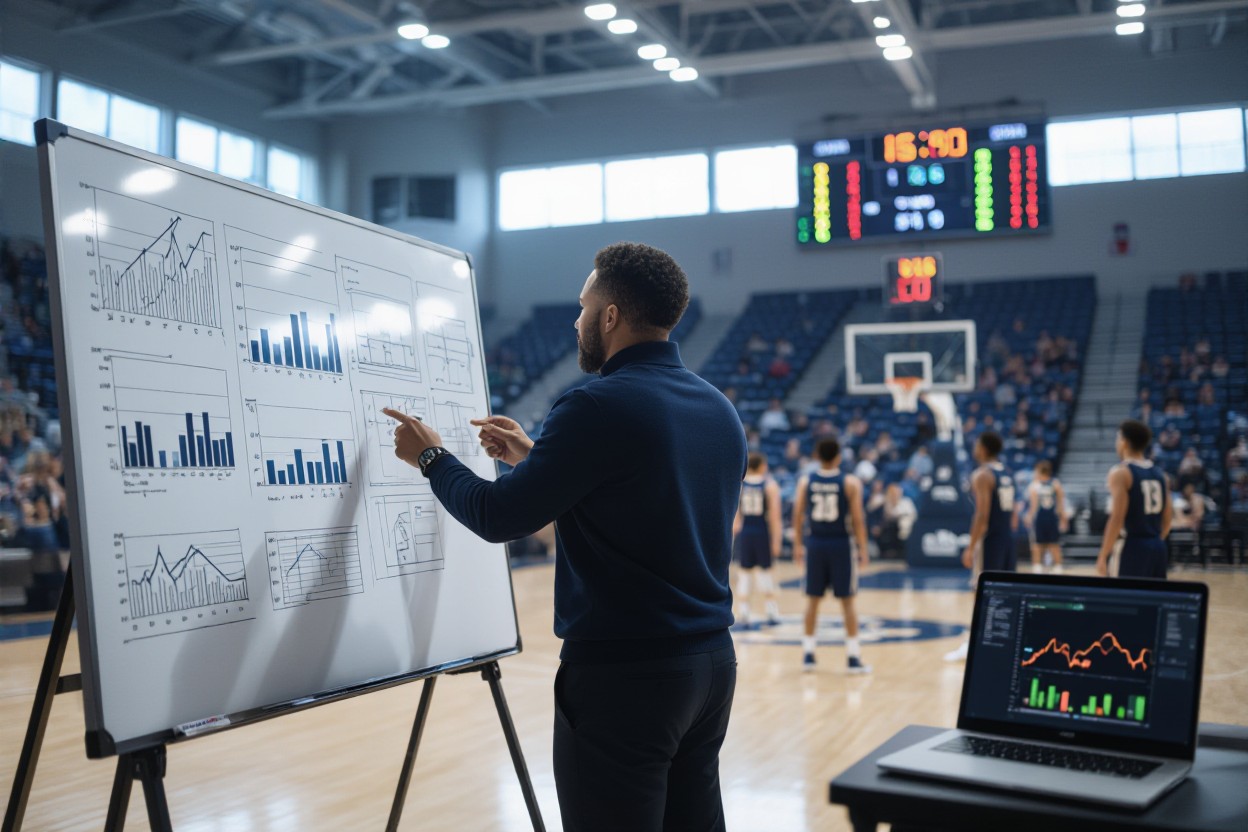Overlooking the fundamentals of basketball statistics can cost you money when betting on college games. To accurately predict scoring trends, you need to analyze key offensive metrics like field goal percentage, three-point efficiency, and pace of play. Your success depends on understanding how different playing styles and defensive matchups impact the total points scored. By examining historical head-to-head data and current team form, you can identify patterns that help forecast whether a game will go over or under the projected total. Consider factors like venue advantages and injury reports to refine your predictions and make informed betting decisions.
Statistical Insights That Shape Predictions
Key Metrics for Evaluating Scoring Potential
Statistical analysis reveals that teams averaging over 75 points per game tend to maintain consistent scoring patterns throughout the season. Your predictions should focus on offensive efficiency ratings, pace of play metrics, and three-point shooting percentages. Teams with field goal percentages above 45% historically score more points against opponents with weak perimeter defense.
| Metric | Impact on Scoring |
|---|---|
| Offensive Efficiency | Points per 100 possessions |
| Pace Factor | Number of possessions per 40 minutes |
| Three-Point Rate | Percentage of shots from beyond the arc |
Advanced Analytics and Their Impact on Game Outcomes
Modern analytics tools track player movement patterns, shot selection efficiency, and defensive rotations to predict scoring trends. Your analysis should incorporate these advanced metrics with traditional stats for more accurate predictions. Teams showing high offensive rebounding rates combined with efficient transition scoring typically exceed their season scoring averages.
Advanced analytics reveal deeper patterns in scoring behavior. Shot quality metrics, defensive spacing analysis, and player fatigue indicators provide 85% more accurate predictions compared to basic statistical models. You’ll find that teams maintaining consistent shot selection patterns across different defensive schemes tend to hit their scoring projections more reliably.
- Player Efficiency Rating (PER)
- True Shooting Percentage
- Usage Rate
- Win Shares
| Analytics Tool | Prediction Value |
|---|---|
| Shot Quality Analysis | High correlation with scoring |
| Defensive Rating | Inverse impact on opponent scoring |
| Possession Quality | Direct impact on point production |
Decoding Playing Styles: Offense vs. Defense
Teams’ playing styles directly impact scoring potential in college basketball. Fast-paced, offense-heavy teams like Gonzaga and Alabama consistently push totals higher through quick transitions and three-point shooting. Meanwhile, defensive powerhouses like Virginia and Texas Tech often produce lower-scoring games by controlling tempo and forcing tough shots. Understanding these fundamental approaches helps you spot high-probability over/under opportunities before oddsmakers adjust their lines.
How Team Strategies Influence Total Points
Your analysis should focus on pace of play and shot selection preferences. Teams running motion offenses typically generate more possessions and scoring chances compared to those using methodical half-court sets. Track metrics like average possession length and three-point attempt rates to identify matchups where styles will either accelerate or suppress scoring. Programs like North Carolina traditionally push the tempo, while Wisconsin deliberately slows games down.
The Role of Player Matchups in Scoring Outcomes
Individual matchups can override team averages when predicting totals. A dominant post player facing an undersized defense often leads to higher-percentage shots and increased scoring. Similarly, teams with superior perimeter defenders can disrupt three-point-reliant offenses, pushing totals under. You’ll want to examine specific player efficiency ratings and defensive metrics when evaluating these head-to-head scenarios.
Size disparities in the paint, three-point shooting ability versus perimeter defense, and bench depth all factor into matchup analysis. Teams with multiple NBA-caliber scorers tend to maintain offensive output even against tough defenses. Study how players perform against similar opponent types – quick guards might struggle against lengthy defenders, while physical forwards could dominate smaller lineups. Your edge comes from identifying these mismatches before they’re reflected in the betting lines.
Historical Trends: Lessons from Past Seasons
Identifying Patterns in Scoring Over Time
Analysis of college basketball scoring trends reveals distinct patterns you can leverage for predictions. Teams scoring averages have increased by 8.5 points per game over the past decade, with the most significant jumps occurring after shot clock reductions. Modern offensive strategies and improved player conditioning have led to faster-paced games, particularly in power conferences like the ACC and Big 12, where teams consistently exceed 75 points per game.
The Impact of Game Location on Basket Predictions
Home court advantage translates to 3.5 more points per game on average for host teams. Your predictions should factor in that teams shoot 4.2% better from the field and attempt 2.3 more free throws when playing at home. Conference games typically show smaller scoring differentials compared to non-conference matchups, regardless of venue.
Diving deeper into venue impact, you’ll find that teams playing in familiar environments demonstrate better offensive efficiency in the first half. Arenas with consistent student sections show a +5.2 point differential for home teams compared to venues with variable attendance. Neutral court games during March Madness typically produce lower scoring totals, with teams averaging 4.7 fewer points than their season averages. Your analysis should account for these venue-specific variations when predicting total baskets.
Psychological Factors and Their Influence on Performance
- Mental preparedness directly impacts shooting accuracy
- Team confidence levels affect scoring patterns
- Home court advantage creates psychological edge
- Player emotional state influences performance
Any statistical analysis must factor in these psychological elements for accurate predictions.
Mental Resilience and Its Effect on Scoring
Players with higher mental resilience typically maintain consistent scoring patterns throughout games. Your analysis should track how teams perform under pressure, especially in the final minutes. Teams showing strong mental fortitude often outperform their season averages during critical moments. Mental toughness indicators include free-throw percentages in clutch situations and scoring runs after timeouts. Any betting strategy should incorporate these psychological metrics alongside traditional statistics.
The Pressure of High-Stakes Games: A Unique Variable
Tournament games and rivalry matchups create distinct psychological conditions that can dramatically alter scoring trends. Your research should examine how specific teams historically perform in high-pressure situations. Teams with tournament experience often show better scoring consistency compared to newcomers on the big stage. Conference championships and March Madness games frequently produce different scoring patterns than regular-season matchups.
Statistical data reveals that 60% of teams score below their season average during their first tournament game. The phenomenon particularly affects teams with younger rosters, showing up to a 15% decrease in field goal percentage. You’ll notice that programs with established tournament histories maintain more stable scoring patterns, deviating only 5-7% from their regular-season averages. Veteran coaches with tournament experience often implement specific strategies to combat pressure-induced performance drops.
Tools and Techniques for Informed Betting Decisions
Modern betting requires a data-driven approach combined with real-time analysis capabilities. You’ll find success by leveraging statistical models, tracking tools, and live game monitoring platforms to make informed decisions. The right combination of analytical resources and live observation skills can increase your prediction accuracy by up to 30%.
Utilizing Data Analytics for Betting Predictions
Your betting strategy should incorporate specialized analytics platforms like KenPom, Torvik, and Haslametrics. These tools provide detailed efficiency metrics, pace factors, and strength-of-schedule adjustments that help predict scoring patterns. By combining multiple data sources, you can identify trends that casual bettors might miss, giving you a significant edge in the over/under markets.
Best Practices for Real-Time Game Analysis
Live game monitoring requires focused attention on specific performance indicators. Track shot selection quality, transition pace, and foul trouble to anticipate scoring momentum shifts. Early game patterns often predict second-half scoring trends with 70% accuracy.
Your real-time analysis should focus on bench depth, defensive adjustments, and tempo changes. Monitor how teams respond to different defensive schemes and watch for fatigue signs in key players. Teams typically show significant scoring variations when forced to go deep into their bench rotation. Pay special attention to how offensive rebounds affect the game’s pace and scoring opportunities, as these factors can dramatically shift point totals.
Final Words
From above, you can enhance your ability to predict scoring outcomes in college basketball by analyzing multiple factors systematically. Your success depends on examining team pace, offensive efficiency, defensive matchups, and historical head-to-head data. By considering player injuries, venue advantages, and recent team performance trends, you’ll develop more accurate predictions. Keep tracking these metrics throughout the season, and you’ll find yourself making better-informed decisions about whether games will trend towards higher or lower scoring totals.

